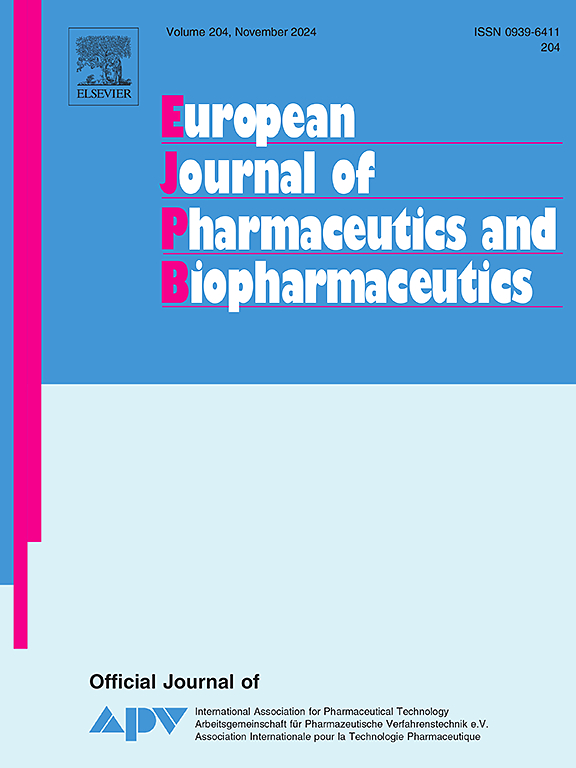Development and characterization of novel fast-dissolving pentobarbital suppositories for pediatric procedural sedation and comparison with lipophilic formulations
IF 4.4
2区 医学
Q1 PHARMACOLOGY & PHARMACY
European Journal of Pharmaceutics and Biopharmaceutics
Pub Date : 2024-10-11
DOI:10.1016/j.ejpb.2024.114532
引用次数: 0
Abstract
For pediatric radiological procedures (RP), pentobarbital sodium (PNa) can be used orally or rectally to replace intravenous anesthesia. Since no commercial PNa suppositories exist, they must be prepared by compounding pharmacies. This study aims to develop fast-dissolving PNa suppositories for fast pharmacological activity during RP. We prepared gelatin (G), gelatin/polyethylene glycol 4000 (GP), and polyethylene glycol 4000 (P) suppositories, with and without pH adjustment, and assessed their dosage uniformity (DU), softening time, rupture resistance, and in-vitro dissolution. An optimal formulation was selected, and PNa release was compared to that of fat-based suppositories using dissolution tests. Additionally, the quality control process (analytical performance, safety/eco-friendliness and productivity/practical effectiveness) of these formulas were compared using a RGB method. All hydrophilic formulas (HF) met the DU requirement (AV < 8 %) except for P (AV 15.62 ± 4 %). pH adjustment enhanced G and GP suppositories resistance to 2.2 ± 0.2 kg and 2.0 ± 0.3 kg, respectively, and allowed 100 % release of PNa in under 10 min. In contrast, lipophilic formulas released less than 80 % of PNa at best after 120 min. These results show the biopharmaceutical suitability of HF for RP compared to lipophilic ones, but a pharmacokinetic study is needed to confirm data.

用于儿科手术镇静的新型快速溶解戊巴比妥栓剂的开发和表征以及与亲脂配方的比较
在儿科放射治疗过程(RP)中,戊巴比妥钠(PNa)可通过口服或直肠使用来替代静脉麻醉。由于目前还没有商品化的戊巴比妥钠栓剂,因此必须由复合药房配制。本研究旨在开发快速溶解的 PNa 栓剂,以便在 RP 期间快速发挥药理作用。我们制备了明胶(G)、明胶/聚乙二醇 4000(GP)和聚乙二醇 4000(P)栓剂,并评估了它们的剂量均匀性(DU)、软化时间、抗破裂性和体外溶解度。通过溶出试验,选出了最佳配方,并将 PNa 的释放与脂肪栓剂进行了比较。此外,还使用 RGB 方法比较了这些配方的质量控制过程(分析性能、安全性/环保性和生产率/实用效果)。除 P(AV 15.62 ± 4 %)外,所有亲水性配方(HF)均符合 DU 要求(AV < 8 %)。pH 值调整后,G 和 GP 栓剂的耐受性分别提高到 2.2 ± 0.2 kg 和 2.0 ± 0.3 kg,并能在 10 分钟内 100 % 释放 PNa。相比之下,亲脂配方在 120 分钟后释放的 PNa 最多不到 80%。这些结果表明,与亲脂配方相比,HF 更适合用于 RP 的生物制药,但需要进行药代动力学研究来确认数据。
本文章由计算机程序翻译,如有差异,请以英文原文为准。
求助全文
约1分钟内获得全文
求助全文
来源期刊
CiteScore
8.80
自引率
4.10%
发文量
211
审稿时长
36 days
期刊介绍:
The European Journal of Pharmaceutics and Biopharmaceutics provides a medium for the publication of novel, innovative and hypothesis-driven research from the areas of Pharmaceutics and Biopharmaceutics.
Topics covered include for example:
Design and development of drug delivery systems for pharmaceuticals and biopharmaceuticals (small molecules, proteins, nucleic acids)
Aspects of manufacturing process design
Biomedical aspects of drug product design
Strategies and formulations for controlled drug transport across biological barriers
Physicochemical aspects of drug product development
Novel excipients for drug product design
Drug delivery and controlled release systems for systemic and local applications
Nanomaterials for therapeutic and diagnostic purposes
Advanced therapy medicinal products
Medical devices supporting a distinct pharmacological effect.

 求助内容:
求助内容: 应助结果提醒方式:
应助结果提醒方式:


